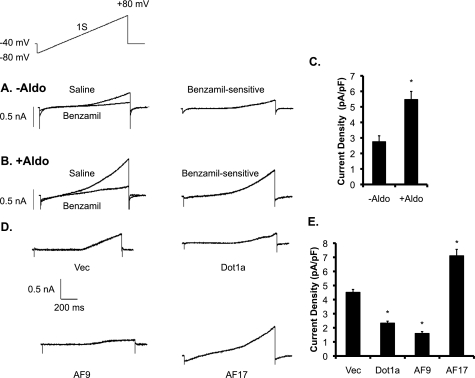FIGURE 8.
Aldosterone and ENaC transcriptional regulators regulate ENaC current. A and B, representative traces of whole-cell recordings from cells 24 h after the onset of exposure to equal volume of ethanol as a vehicle control (−Aldo) or 1 μm aldosterone (+Aldo) as indicated. Currents were recorded during a 1-s voltage ramp (−80 to +80 mV) delivered from a holding potential of −40 mV (shown as the inset above the current traces). Currents were obtained in normal external saline and after superfusion of saline containing 10 μm benzamil, as shown in the traces to the left. For each cell, benzamil-sensitive currents were then computed by digital subtraction and are shown in the traces on the right. Under these recording conditions, benzamil-sensitive currents show strong outward rectification. C, mean current density is shown of benzamil-sensitive currents at +80 mV from HEK293 cells treated with vehicle (n = 12) or aldosterone (n = 13). *, p < 0.05 versus −Aldo. pF, picofarads. D–E, effects are shown of transcriptional regulators on ENaC currents in HEK 293T cells. D, representative examples are shown of whole-cell recordings of benzamil-sensitive currents from HEK 293T cells 24 h after transient transfection with expression plasmids encoding GFP (Vec) or one of the GFP-tagged transcriptional regulators (GFP-Dot1a, GFP-AF9, and GFP-AF17) as indicated. Benzamil-sensitive currents recorded from fluorescent cells during application of voltage ramps were obtained by digital subtraction as described above. E, mean densities of benzamil-sensitive currents at +80 mV are compiled from 12 cells in each group. *, p < 0.05 versus vector (Vec).

